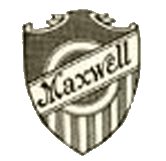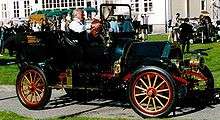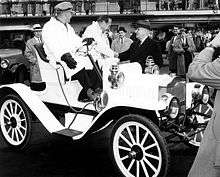Maxwell automobile
 | |
| Automobile Manufacturing | |
| Industry | Automotive |
| Fate | Acquired by Walter Chrysler |
| Successor | Chrysler |
| Founded | 1904 |
| Founder |
Jonathan Dixon Maxwell & Briscoe Brothers Metalworks |
| Defunct | 1925 |
| Headquarters |
Tarrytown, New York Detroit, Michigan |
The Maxwell was a brand of automobiles manufactured in the United States of America from about 1904 to 1925. The present-day successor to the Maxwell company is Fiat Chrysler Automobiles.[1]
History
The brand name of these motor cars was started as the Maxwell-Briscoe Company of Tarrytown, New York. The company was named after founders Jonathan Dixon Maxwell, who earlier had worked for Oldsmobile, and the Briscoe Brothers Metalworks. Benjamin Briscoe, an automobile industry pioneer, was president of the company at its height.
In 1907, following a fire that destroyed the Tarrytown, NY, factory, Maxwell-Briscoe constructed what was then the largest automobile factory in the world in New Castle, Indiana. This factory continued as a Chrysler plant until its demolition in 2004.
Maxwell was the only profitable company of the combine named United States Motor Company, which was formed in 1910. Due to a conflict between two of its backers, the United States Motor Company failed in 1913 after the failure of its last supporting car manufacturer, the Brush Motor Company. Maxwell was the only surviving member of the combine.
In 1913, the Maxwell assets were purchased by Walter Flanders, who reorganized the company as the Maxwell Motor Company, Inc.. The company moved to Highland Park, Michigan. Some of the Maxwells were also manufactured at two plants in Dayton, Ohio.[2] For a time, Maxwell was considered one of the three top automobile firms in America, along with General Motors and Ford (though the phrase "the Big Three" was not used at the time). By 1914, Maxwell had sold 60,000 cars.[3]
The company responded to the increasing number of low-priced cars—including the $700 Ford Model N, the $485 Brush Runabout,[4] the Black at $375,[5] the $500 Western Gale Model A,[6] the high-volume Oldsmobile Runabout at $650,[7] and the bargain-basement Success an amazingly low $250)[7]—by introducing the Model 25, their cheapest four yet.[8] At $695, this five-seat tourer had high-tension magneto ignition,[8] electric horn and (optional) electric starter and headlights, and an innovative shock absorber to protect the radiator.[8]

Maxwell eventually over-extended and wound up deeply in debt, with over half of its production unsold in the post-World War I recession in 1920. The following year, Walter P. Chrysler arranged to take a controlling interest in Maxwell. One of his first tasks was to correct the faults in the Maxwell, whose quality had faltered. This improved version of the car was marketed as the "Good Maxwell."[9] [10]
Maxwell Motors was re-incorporated in West Virginia with Walter Chrysler as the chairman. Around the same time that this was happening Maxwell was also in the process of merging, awkwardly at best, with the ailing Chalmers Automobile Company.[11] Chalmers ceased production in late 1923.[11]
In 1925, Chrysler formed his own company, the Chrysler Corporation. That same year, the Maxwell line was phased out and the Maxwell company assets were absorbed by Chrysler. The Maxwell car would continue to live on in another form however, because the new 4-cylinder Chrysler model F-58 which was introduced for the 1926 model year was created largely from the design of the previous year's Maxwell.[12] And this former Maxwell would undergo yet another transformation in 1928, when a second reworking and renaming would bring about the creation of the first Plymouth.[12]
Marketing to women
Maxwell was one of the first car companies to specifically market to women. In 1909 it generated a great deal of publicity when it acted as the sponsor for the first woman to drive coast-to-coast across the United States. This achievement was accomplished by Alice Huyler Ramsey, who was an early advocate of women drivers. By 1914 the company had strongly aligned itself with the women's rights movement. That year it announced its plan to hire as many male sales personnel as female. At that time it offered a promotional reception at its Manhattan dealership which featured several prominent suffragettes such as Crystal Eastman, while in a showroom window a woman assembled and disassembled a Maxwell engine in front of onlookers.[13]
In media

In 1920 the Maxwell Company contracted with actor and producer Nell Shipman to create a short promotional film featuring the Maxwell. She was able to stretch the money budgeted for the project into a multi-reel feature entitled Something New.[14] The Maxwell's abilities were prominently featured in this melodramatic film, which had Nell Shipman and Bert Van Tuyle escaping a band of Mexican bandits by racing the sturdy little car across the Mexican badlands where they overcame obstacles such as boulders, steep hills, rivers, gulches, and all other sorts of rough terrain. Maxwell dealers presented this motion picture at various venues to promote the car, often with the now-battered Maxwell on display. The Maxwell Company had assisted in the film's production by supplying a car and by deploying a mechanic to the filming location. The mechanic's job included repeatedly replacing the car's transmission, which kept getting torn up by the harsh desert landscape.[15]
A decrepit old Maxwell was famous as the car Jack Benny drove decades after it had stopped being manufactured. The running joke was that Benny was too stingy to buy himself a new car — or even a newer used car — as long as his old one still ran, however poorly. The sounds used for it used to be pre-recorded, but when a technical fault prevented the recording from playing, voice actor Mel Blanc himself improvised the sounds of the sputtering car starting up. His performance was received well enough for him to continue the role permanently.
See also
- Carl Breer
- List of defunct United States automobile manufacturers
- Watch the 1920 movie "Something New" featuring the robust Maxwell-car in a 1-hr. extremely grueling albeit entertaining mountain-terrain ordeal .
Notes
- ↑ Darke, Paul. "Chrysler: The Baby of the Big Three", in Northey, Tom, ed. World of Automobiles (London: Orbis, 1974), Vol. 4, p.366.
- ↑ Williams' Dayton Directory (Cincinnati: Williams Directory Co., 1913), 876.
- ↑ Clymer, Floyd. Treasury of Early American Automobiles, 1877-1925 (New York: Bonanza Books, 1950), p.148.
- ↑ Clymer, p.104.
- ↑ Clymer, p.61.
- ↑ Clymer, p.51.
- 1 2 Clymer, p.32.
- 1 2 3 Clymer, p.148.
- ↑ Kimes, Beverly Rae; Clark, Jr., Henry A. Standard Catalog of American Cars 1805-1942 (second edition). Krause Publications. p. 901. ISBN 0-87341-111-0.
- ↑ "The Good Maxwell". Automobile Topics (advertisement): 2. 1922-06-03. Retrieved 2016-08-26.
- 1 2 Kimes, Beverly Rae; Clark, Jr., Henry A. Standard Catalog of American Cars 1805-1942 (second edition). Krause Publications. p. 257. ISBN 0-87341-111-0.
- 1 2 Kimes, Beverly Rae; Clark, Jr., Henry A. Standard Catalog of American Cars 1805-1942 (third edition). Krause Publications. p. 1198. ISBN 0-87341-428-4.
- ↑ Scharff, Virginia (1991). Taking the Wheel: Women and the Coming of the Motor Age. Free Press. p. 84. ISBN 0-8263-1395-7. Retrieved 2016-08-25.
- ↑ Armatage, Kay (2003). The Girl from God's Country: Nell Shipman and the Silent Cinema. University of Toronto Press Incorporated. p. 137. ISBN 0-8020-8542-3. Retrieved 2016-01-31.
- ↑ Shipman, Nell; Trusky, Tom (1987). The Silent Screen & My Talking Heart: An Autobiography. Boise State University. pp. 87–88. ISBN 0-9321-2904-8. Retrieved 2016-01-31.
Sources
- Clymer, Floyd. Treasury of Early American Automobiles, 1877-1925. New York: Bonanza Books, 1950.
- Darke, Paul. "Chrysler: The Baby of the Big Three", in Northey, Tom, ed. World of Automobiles, Vol. 4, pp. 364–9. London: Orbis, 1974.
- Kimes, Beverly Rae, and Clark, Henry Austin, Jr. Standard Catalog of American Cars, 1805-1942 (second edition). Krause Publications, Inc. 1989. ISBN 0-87341-111-0.
- Kimes, Beverly Rae, and Clark, Henry Austin, Jr. Standard Catalog of American Cars, 1805-1942 (third edition). Krause Publications, Inc. 1996. ISBN 0-87341-428-4.
- Yanik, Anthony J. Maxwell Motor and the Making of the Chrysler Corporation. Detroit: Wayne State University Press, 2009. ISBN 9780814334232.
External links
| Wikimedia Commons has media related to Maxwell vehicles. |
- Maxwell: First Builder of Chrysler Cars at Allpar.com
- Maxwell/Maxwell-Briscoe with photos of various Maxwells
- Early Chrysler history (including Maxwell)